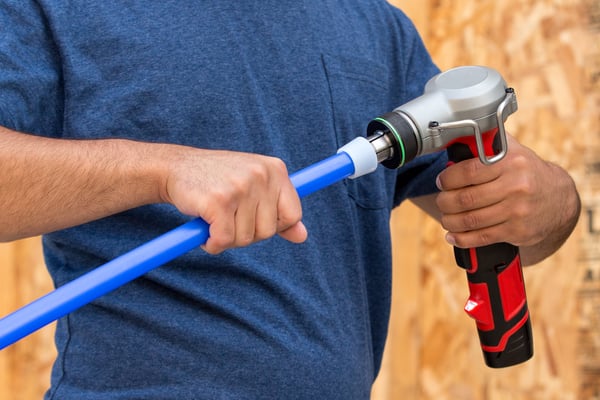From beginnings to fittings and every application and connection in between
In the mid-1900s, indoor pipes consisted of copper and metal materials. These plumbing solutions became problematic against corrosive environments. Pitting of the pipes put in question the integrity of the water supply and users at risk.
Enter Engel...
Pioneering PEX
German inventor, Thomas Engel, pioneered a new way of piping by crosslinking polyethylene using a peroxide method. This method proved both more cost-effective and long-lasting—the piping held up to heat, it was easier to work with during installation, and more reliable against corrosion over time.
By the 1980s, homes and businesses were using PEX for plumbing projects and radiant floor heating inside their buildings. There are three types still used by contractors: Engel’s or PEXa, the Silane process or PEXb and Electron Beam method or PEXc.
PEX A vs PEX B
PEX A uses larger-diameter expansion-style fittings, requiring an expansion tool to enlarge the pipe and sleeve. Its unique expandable nature, driven by memory features, ensures a snug fit when it contracts back to its original size around the fitting.
PEX A offers exceptional flexibility, enabling tighter radial bends and easy kink repair with a heat gun. The material can expand back to its original shape.
Pros: PEX A ensures unrestricted flow with matching pipe and fitting diameters, making it ergonomic for tight spaces and quick connections in challenging areas like joist bays.
Con: In cold climates expansion fittings may delay their return to the original size. Solution? Use a heat gun to speed up the contraction.
PEX B
PEX B utilizes insert-style fittings by inserting them into the pipe and securing them with a copper sleeve using a crimp tool.
PEX B, although made of similar material as PEX A, has limited flexibility. In case of kinks, repairs are impossible, necessitating the replacement of the affected section.
Pros: PEX B offers a tool-free, consistent joining method that's quick and easy in any weather.
Con: PEX B fittings reduce flow and water volume at the joint due to their smaller diameter and may result in leaks if crimped incorrectly.
PEX b built on Engel’s novel PEX a by crosslinking through a physical, chemical process, essentially fortifying the pipe’s high temperature threshold, resistance to UV rays and harsh or acidic elements, and overall toughness. Even with the robust reinforcement, PEX b proved to be just as flexible on the job. Today, this is by far the most widely used solution for all the above. We’re talking like well over half of all plumbing projects.
In frigid climates, freezing pipes and potential bursts are worrisome. PEX A offers higher burst resistance, capable of withstanding up to 500 PSI in extreme cold, while PEX B, being more rigid, is less resilient.
The manufacturing enhancement opened the door (literally) to more outside applications for both residential and commercial spaces, such as irrigation systems, radiant heating on sidewalks and driveways, and outdoor water systems.
PEX a and PEX c also meet these jobsite requirements for these applications. They’re closer than cousins to PEX b. All follow crosslinking methods. All must be tested and third-party certified to meet ASTM standards in North America. However, PEX b boasts performance advantages over other crosslinking methods, such as UV and chlorine resistance, thermo stability, and burst strength.
Expanding the Way of Connecting
PEX b is expanding on its capabilities too when it comes down to the connection. PEX b used to be limited to crimp fittings for installation, while PEX a offered a larger opening for expansion fittings. Through meticulous enhancements, PEX b expanded its way of connecting. PEX b pipes are now fully certified for use with both ASTM F1807/F2159 crimp and ASTM F1960 expansion fittings and accessories.
What does this mean? Well, expansion PEX can offer a path of leak resistance if used with a certified expansion tool. Certified tool heads feature interlocking teeth and unique nose design, specifically for PEXb. This industry innovations allows homeowners and building owners to upgrade to the strength of PEX b without worrying about complications during installation or difficulties in cold weather conditions.
PEX Expansion Tool
The Zurn PEX F1960 Expansion Head, compatible with DEWALT® DCE400 and Milwaukee® M12™ ProPEX® Tools, streamlines PEX system assembly, ensuring leak-free connections. Designed for Zurn Non-Barrier PEX pipe, it creates secure connections with ASTM F1960 fittings.
Choosing PEX for Your Project
No matter, which option you choose—a, b, or c—PEX surpasses copper piping for reliability across all indoor applications. You’re guaranteed to save project costs and labor and extend the lifespan of your system with fewer maintenance requests or problems down the road with your water source. However, if you’re looking to get more creative outdoors or want more jobsite flexibility, you may want to consider PEXb.
It’s hard to say what’s next for PEX. But seeing as it’s the most versatile solution in the plumbing world, we can only expect another advancement or discovered use in time.






